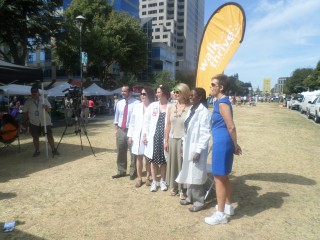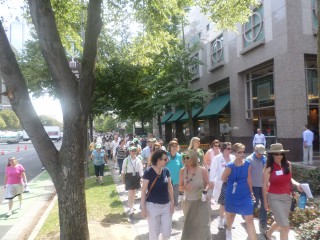A region-wide coalition of public health organizations launched a collaborative effort today in response to the U.S. Surgeon General’s September 9, 2015 Call to Action for Walkability and Walkable Communities, titled “Step It Up.” This kickoff was held at 11:30am in conjunction with Kaiser Permanente’s weekly “Walk to Thrive” public walking event sponsored by the Downtown Sacramento Partnership.
Speakers included Secretary Diana Dooley of the California Health and Human Services Agency, Dr. Karen Smith, Director and State Health Officer, California Department of Public Health, Dr. Shelley Garone, Hospice and Palliative Care, Kaiser Permanente, and Doctor Olivia Kasirye, Public Health Officer, County of Sacramento.
“As the host of the weekly Walk to Thrive downtown walking program at the Capitol Mall Farmer’s Market in Sacramento, Kaiser Permanente welcomes the U.S. Surgeon General’s call to action,” said Robert Azevedo, the physician-in-chief for Kaiser Permanente Sacramento Medical Center. “We know that walking just 30 minutes a day can lower blood pressure, strengthen heart muscles, and reduce cancer risks, among other health benefits.
“Everyone deserves to have a safe place to walk or wheelchair roll. But in too many of our communities, that is not the reality,” said Dr. Vivek H. Murthy, the 19th U.S. Surgeon General when he launched the campaign on September 9th. “We know that an active lifestyle is critical to achieving good overall health. And walking is a simple, effective and affordable way to build physical activity into our lives. That is why we need to step it up as a country ensuring that everyone can choose to walk in their own communities.” The Call to Action includes five strategic goals to promote walking and walkable communities: make walking a national priority; design communities that make it safe and easy to walk and roll for people of all ages and abilities; promote programs and policies to support walking where people live, learn, work, and play; provide information to encourage walking and improve walkability; and fill surveillance, research, and evaluation gaps related to walking and walkability.
The need for walkability and active design in our communities is a cornerstone issue, with access to sidewalks, buildings, and other pedestrian- and wheelchair-friendly facilities being essential features of our built environment. Leaders in Sacramento and across California have been working toward the goals in the Surgeon General’s Call for years.
About Current Walkability and Active Design Efforts in the Capitol Region
WALKSacramento and our advisory committee, Design 4 Active Sacramento, will soon begin working with the Sacramento Area Council of Governments on Advancing Healthy Communities through Active Design/Transportation Implementation. To support the location- and resource-efficient development pattern of the MTP/SCS, this project offers expertise and best practices to jurisdictions on attracting infill residential and economic development, and creating mixed use, walkable, bikeable and transit-friendly developments, commercial corridors and complete streets that will reduce auto trips, energy use and household transportation costs, while improving individual and community health.
WALKSacramento, a leader in the region on improving the walkability of streets, neighborhoods, and communities will provide a key piece of this assistance. As part of the active/design transportation component of the project, WALKSacramento and additional transportation consultant/traffic engineer(s) will provide guidance and assistance to local governments on implementing policies and plans for complete streets and corridor improvements. WALKSacramento will also work with developers on how to improve development projects to support walking and biking, improve safety, access and the pedestrian environment, and help make more compact infill developments healthy and attractive to residents and the surrounding community.
This project focuses on urban, suburban and rural jurisdictions across the region, including the cities of Citrus Heights, Davis, Elk Grove, Folsom, Isleton, Lincoln, Live Oak, Loomis, Marysville, Placerville, Rancho Cordova, Rocklin, Sacramento, West Sacramento, Winters, Woodland, and Yuba City, and the counties of El Dorado, Placer, Sacramento, Sutter and Yolo.


